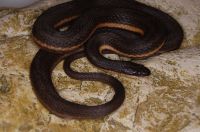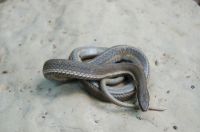Regina septemvittata (Say, 1825)


Key Characters: Yellow stripe on scale rows 1-2; four dark brown stripes on the belly; back scales strongly keeled; anal plate divided.
Similar Species: Graham’s Crayfish Snake. See the Key to Snakes of Illinois for help with identification.
Subspecies: None currently recognized.
Description: Medium-sized (up to 90 cm TL), relatively stout-bodied brown or dark olive water snake. Belly yellow or off-white and boldly marked with two brown stripes down the center and another on each side of belly scales (dark stripes obscured in many older adults).
Habitat: In and along banks of relatively unpolluted, rocky woodland streams where crayfish are abundant.
Natural History: This mainly diurnal snake commonly basks in branches overhanging water, then retreats under rocks in the water, under cover on shore, and down burrows in banks and dams. It mates in late April or May and gives birth to 8-12 young from late July to September. Newborn are 18-20 cm TL. Diet consists almost entirely of soft, recently molted crayfish. Predators include other snakes, shore birds, and mammals. When captured, it seldom bites, but squirms violently and sprays feces and foul-smelling musk.
Status: Threats include water pollution that reduces crayfish populations and siltation of rocky stream bottoms. Uncommon in most of its range, but may be abundant locally in good habitat.
Etymology: Regina – regius (Latin) meaning queen; septemvittata – septem (Latin) meaning seven; vitta (Latin) meaning ribbon, band, stripe
Original Description: Say, T. 1825. Descriptions of three new species of Coluber, inhabiting the United States. Proceedings of the Academy of Natural Sciences Philadelphia. 4 (Part 2):237-241.
Type Specimen: Holotype not designated, but syntypes were at ANSP.
Type Locality: “Pennsylvania”
Original Name: Coluber septemvittatus Say, 1825
Nomenclatural History: Kennicott (1855) used Regina leberis (Dumeril & Bibron 1854) and Davis and Rice (1883) used Tropidonotus leberis to refer to this species. Smith (1961) used the combination Natrix septemvittata.


